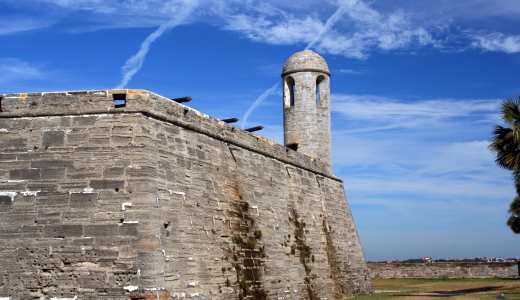
The fight for African American equality, which reached a new high in 2008 with the election of President Barack Obama, is one of the most well known American revolutionary traditions. But what most people don’t realize is how far back it dates: before the 1960s Civil Rights Revolution, before the struggles of the 1930s, before the Civil War, before the American Revolution of 1776 against the British – even before the British themselves arrived in North America.
It reaches, in fact, all the way back to the arrival of the Spanish – along with slaves and free Black Africans – in the 1500s, and an early high point was the establishment, in 1738 by Governor Manuel Mantiano, of Fort Mose, Fla., as a sanctuary for escaped slaves from the British Carolina territory. The town, the first community of free African Americans, existed until 1763, when the British won Florida from Spain and imposed slavery.
The free town was located just south of Saint Augustine.
According to the Fort Mose Historical Society, while most people consider the history of African Americans to begin with the arrival of slaves in Jamestown, there is actually a brighter past alongside, and before, that.
“The first Africans to accompany Europeans in coming to the New World arrived not as slaves in Jamestown in 1619,” notes the organization’s website. “Aboard ships with Spanish conquistadors and Adelantados, Africans arrived as artisans, seamen, navigators and adventurers, forever establishing their presence in North America.”
“In early 1500s,” the history continues, “Juan Garrido took part in the expeditions of Ponce de Leon in Puerto Rico and Florida as well as with Hernando Cortez in Mexico. Esteban joined Panfilo de Narvaez traveling through the Gulf Coast and the Southwest.”
The oldest European settlement in what is now the U.S. is Saint Augustine, Fla., dating back to the mid-1500s. Free Black Africans were an important part of life there. Africans formed 12 percent of the population, the historical society notes, and 20 percent were free.
Of course, as evidenced by its brutal slaughter of the Native American population, Spain wasn’t particularly enlightened. Slaves were kept on its territory, and other European nations had small free African populations. Consequently, it wasn’t Spanish benevolence that led to the eventual acceptance of the liberation movement of former slaves and the formation of Fort Mose, but a convergence of a couple important factors.
First, Spain’s chief enemy was Great Britain, who formed the Carolina colony in 1670. Both Spain and Britain were eyeing each other’s colonies: the British wanted Florida, and the Spanish wanted Carolina as well as areas north.
The second factor was the Black population itself. While the Spanish were far from perfect, African Americans knew that, were Britain to take Florida, it would likely mean slavery for all Blacks. Consequently, in 1683, the first Black militia on modern-day American soil formed in Florida, aimed at defending the colony against the British. Four years later, the Saint Augustine received the first-ever recorded escaped slaves: eleven people, including two women and a child. The governor refused to return them to their Carolinian masters, and put them to work – as wage laborers.
A few years later, Spanish King Charles II made the area a sanctuary for freed British slaves. Around the same time, the slave population of the Carolina colony increased in number beyond that of the whites.
Slaves revolted in 1711 and 1714, and some of them joined a local Native American tribe in its 1715 war against the British. While that war ultimately failed, African Americans had established themselves as a powerful force, and the tradition of anti-slavery resistance took shape.
In 1739, the Spanish established Gracia Real de Santa Teresa de Mose, or Fort Mose, for free African Americans. While it was burned once during the war with the British, it was rebuilt and continued its existence as a free territory for escaped slaves and other African Americans.
The war between Britain and Spain raged on – with the residents of Fort Mose a heroic role in the fights – until the British took control of Florida in 1763. Slavery was re-imposed and continued until its overthrow by Union troops with the conclusion of the Civil War more than 100 years later.
Only in the late 1980s and early 1990s was the site of Fort Mose rediscovered. A few years after that, it was listed as a national landmark. In 2009, the National Parks Service named it as a “precursor site” to the Underground Railroad.
For those who want to visit, the State of Florida maintains it as a park.
Today, Fort Mose stands as a testament to the struggle of African Americans for freedom, which spans back hundreds of years before the United States was founded – and continues today.
Image: The fort itself, photographed by Eric Gorski // CC BY-NC-SA 2.0










